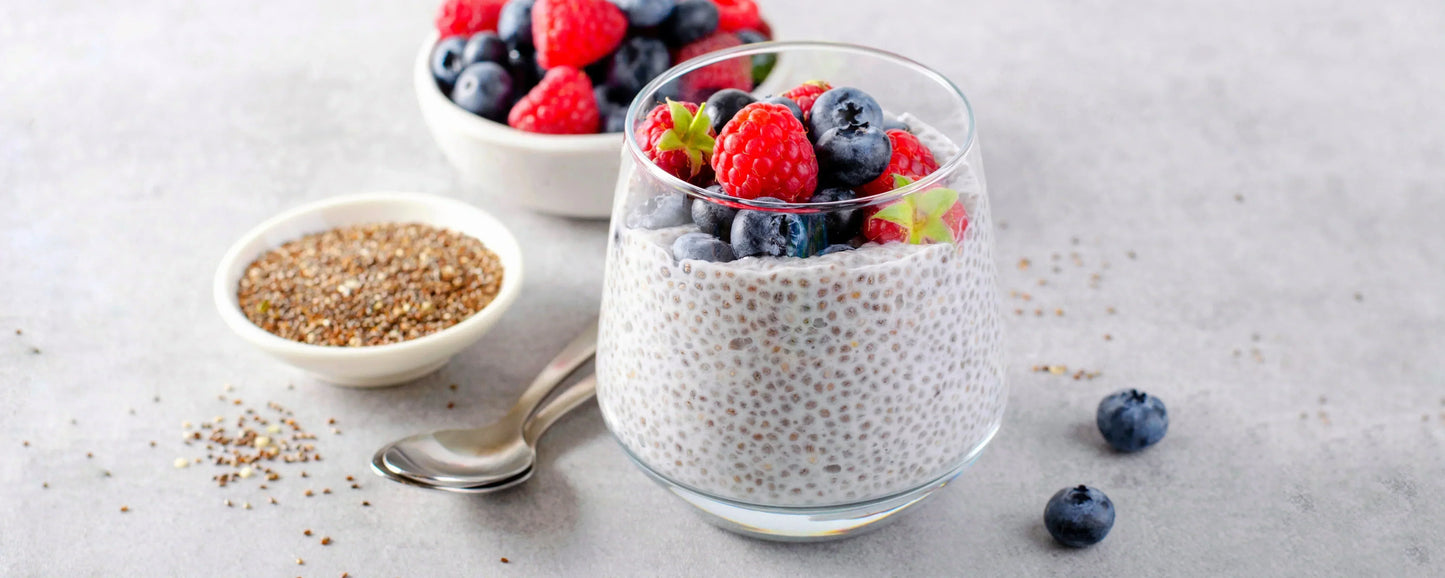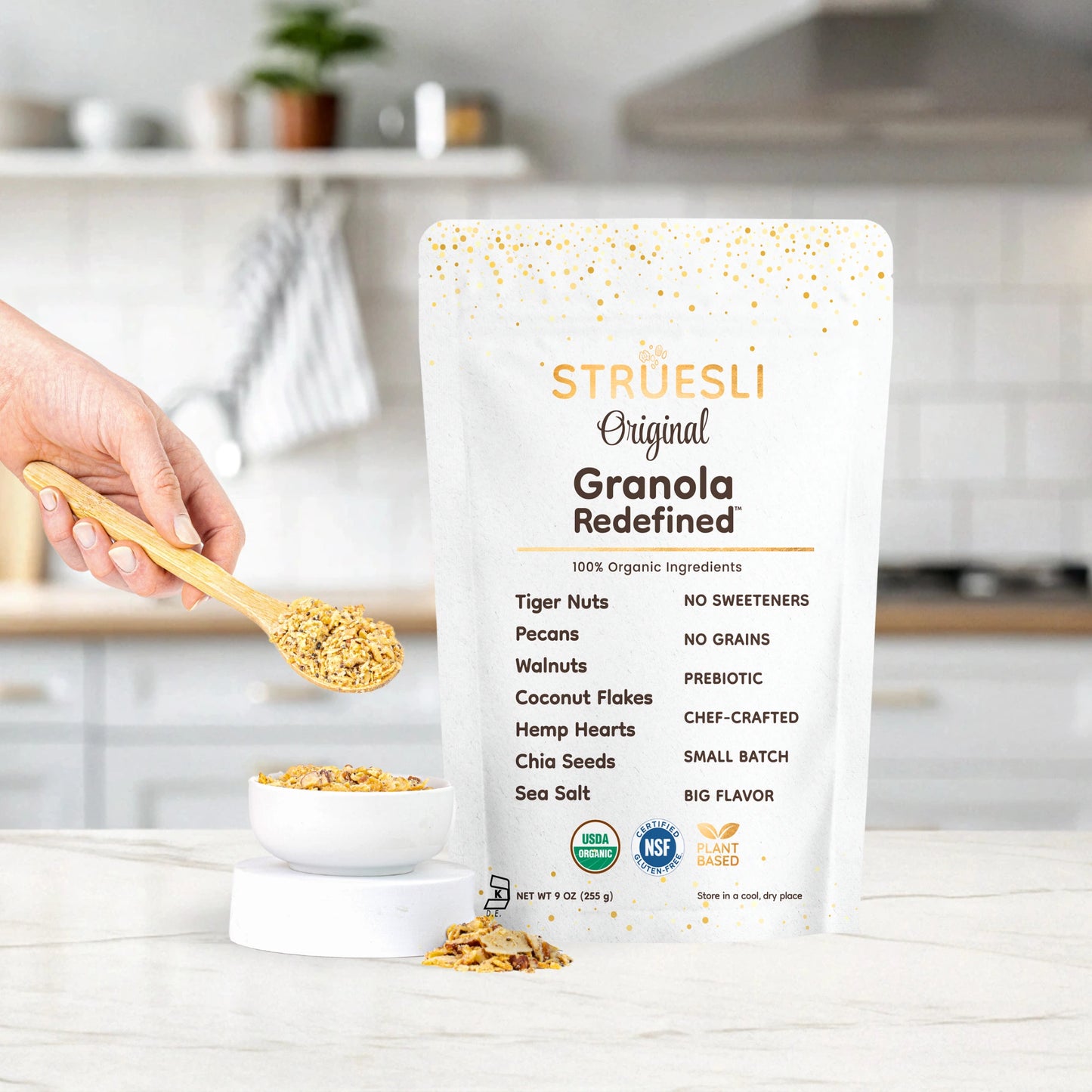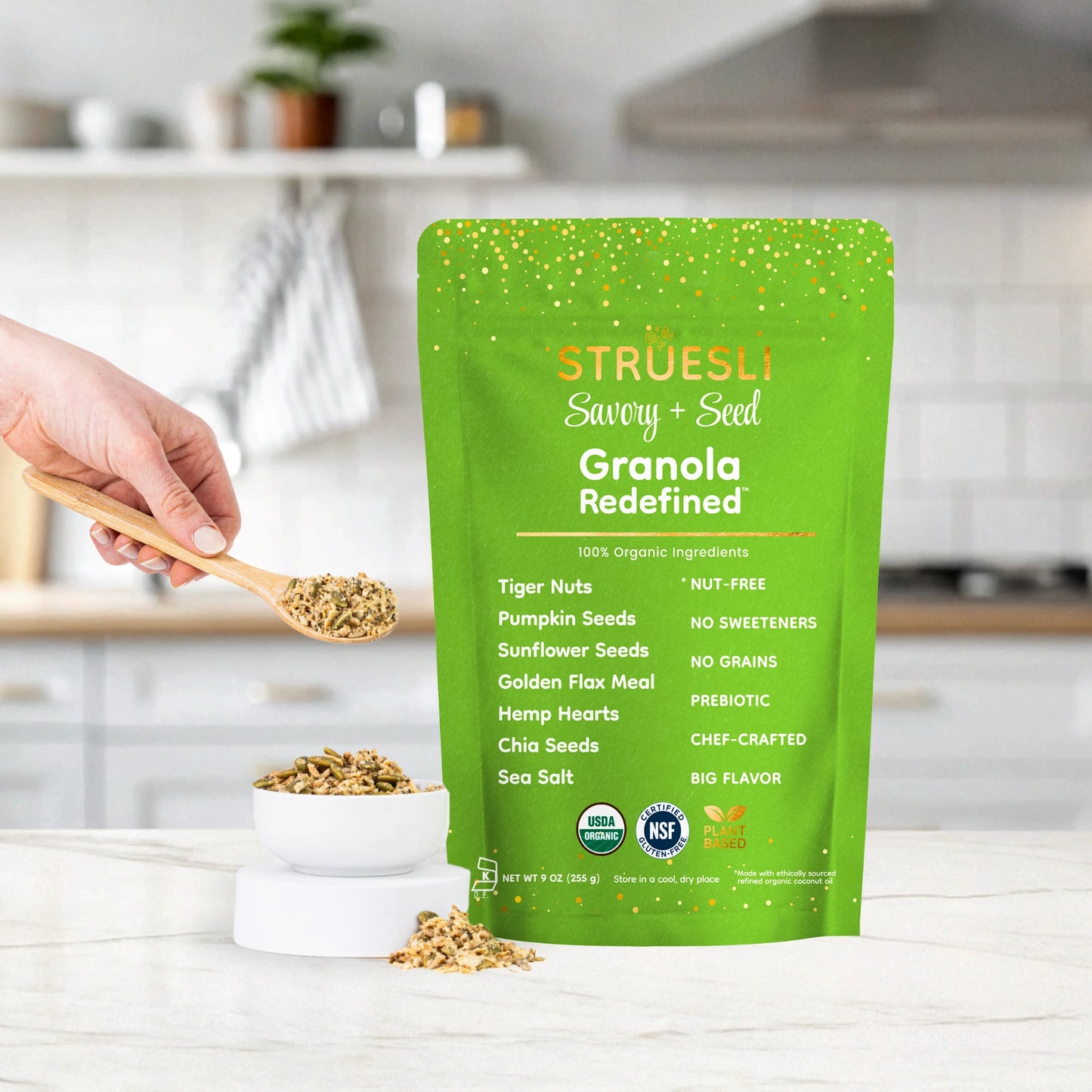
When chef-founder Adrienne created Struesli grain-free granola, she not only wanted it to taste great as a topper for her morning yogurt, she also wanted it to offer the utmost nutrition bang for her buck. And that’s how this popular granola with chia seeds, flax seeds, hemp hearts, tiger nuts, walnuts, pecans, and coconut flakes came to be.
You see, Adrienne was using all of those individual ingredients to sprinkle over her yogurt, each one adding its own health benefits. But then she had the great idea to combine them and bake them into a golden and flavorful crispy granola, where the health sum is greater than its parts. In this article we’ll share more about the chia seeds in our grain-free granola and how they benefit you.
The 4 Main Health Benefits
Even though they’re tiny, chia seeds are one of the healthiest seeds on the planet.
-
A Good Source of Omega-3 Fatty Acids: Just 2 tablespoons of chia seeds provides an excellent amount (more than 5,000 mg) of alpha-linolenic acid (or ALA), which is an important type of omega-3 fat that humans need to get from food. It is key to normal development and growth of human cells and it also plays a role in heart health, by helping the heart pump and maintain a normal rhythm.
-
High in Fiber: A 2-tablespoon serving of chia seeds contains almost 10 grams of fiber. If you’ve ever soaked chia seeds or made chia pudding, you see how they expand in liquid. That reaction is caused by the high amount of insoluble fiber in chia seeds, which is important for digestive health, preventing constipation and bloating. It’s also the type of fiber that helps you feel more full and satiated after eating, warding off hunger cravings and sending signals to your brain that you’ve eaten enough.
-
Minerals for Bone Health: Chia seeds contain high levels of magnesium, phosphorus, and calcium, which are three minerals that play interconnected roles in maintaining strong bones. And having strong bones is essential to healthy aging.
- Rich Source of Antioxidants: Chia seeds contain several powerful antioxidants known as tocopherols, phytosterols, carotenoids, and polyphenolic compounds that have been linked to health benefits. For example, they contain high amounts of caffeic acid and chlorogenic acid that help fight inflammation and have protective effects for the heart.
How Much Chia To Eat Per Day
A general recommendation for how much chia seeds per day for optimal health is a 28-ounce serving, which is a little more than 2 tablespoons. This amount contains nearly 10 grams of fiber, 5 grams of protein, 9 grams of monounsaturated fat including more than 5,000 milligrams of omega-3 fatty acids, and 0 grams of sugar.
Best Way To Eat Chia Seeds
Some of our favorite ways to incorporate chia seeds into the day are:
- Sprinkle on top: Chia can be sprinkled over oatmeal, yogurt, cereal, soups, and salads to add crunch and nutrition.
- Make chia pudding: By soaking chia in milk (non-dairy milks such as almond milk, oat milk, and coconut milk work best), the seeds expand and create a pudding-like texture that is a great canvas for berries, nuts, protein powder, nut butter, and other mix-ins. This grain-free alternative to overnight oats offers protein and fiber for breakfast and makes a healthy snack or dessert.
- Eat more Struesli: Chia seeds are one of several whole-food ingredients that makes Struesli grain-free granola so good and good for you. The chia seeds in Struesli are visible and contribute to the high fiber content and healthy fats in Struesli. By eating 1-2 servings of Struesli a day, you would easily meet the 2 tablespoon daily recommendation of chia seeds.
- Add to smoothies: Adding a scoop of chia seeds is an easy way to incorporate them into a meal replacement or light smoothie snack.
- Incorporate into baked goods: Chia seeds can be added to most batters, including brownies, cakes, and pancakes, to increase the nutrition and add volume at the same time.
- Add to salad dressings: Chia seeds can help create a creamy thick texture in homemade salad dressings and also add healthy fats, protein, and fiber to a salad.
Who Should (And Shouldn’t) Eat Chia Seeds
Most adults would benefit by eating more chia seeds, starting by incorporating ½ to 1 tablespoon into their daily meal plan and slowly increasing to a 2 to 3 tablespoon serving of chia seeds per day. This increase of chia seeds offers many nutrients that adults need more of, including fiber, omega-3 fats, and antioxidants.
So, if most people should be eating more chia seeds, then who should avoid chia seeds? People who have certain digestive issues may want to limit chia seeds or introduce them slowly. Those include people with Crohn's disease, ulcerative colitis, or diverticulitis. Conditions can vary, so if you have Crohn’s, ulcerative colitis, or diverticulitis, it’s a good idea to talk with your healthcare provider or a local dietitian who can assess your overall diet and diagnosis to see if chia seeds should be avoided or limited. Also, some people have an allergy to chia seeds or take certain medications that may have contraindications with chia seeds.
Learn About More Key Ingredients In Struesli Original:
Written by Jessie Shafer, RD
April 17, 2025




